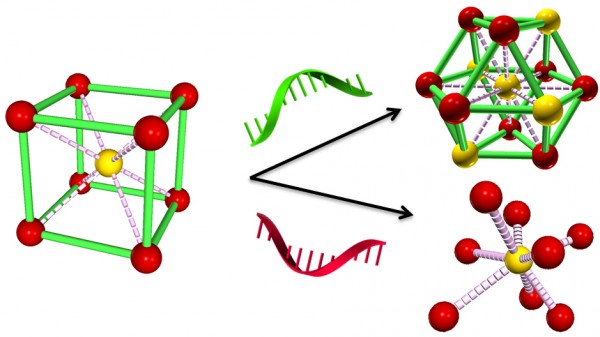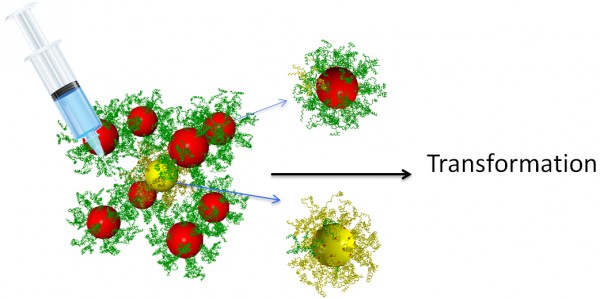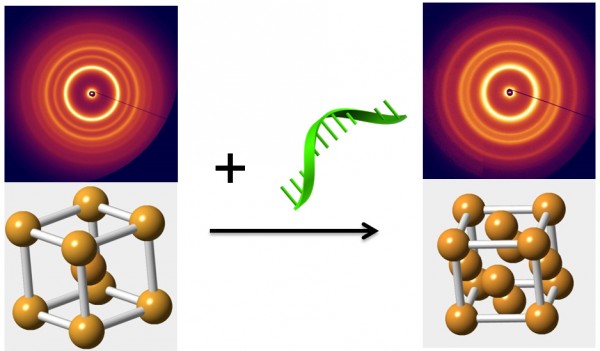Dynamically reprogramming matter
May 26, 2015

Various types of reprogramming DNA strands can be used to selectively trigger transformations to radically different phases (configurations) of the initial particle structure (credit: Brookhaven National Laboratory)
Scientists at the U.S. Department of Energy’s Brookhaven National Laboratory have developed the capability of creating dynamic nanomaterials — ones whose structure and associated properties can be switched, on-demand. In a paper appearing in Nature Materials, they describe a way to selectively rearrange nanoparticles in three-dimensional arrays to produce different configurations, or “phases,” from the same nano-components.
“One of the goals in nanoparticle self-assembly has been to create structures by design,” said Oleg Gang, who led the work at Brookhaven’s Center for Functional Nanomaterials (CFN), a DOE Office of Science User Facility. “Until now, most of the structures we’ve built have been static.” KurzweilAI covered that development in a previous article, “Creating complex structures using DNA origami and nanoparticles.”
The new advance in nanoscale engineering builds on that previous work in developing ways to get nanoparticles to self-assemble into complex composite arrays, including linking them together with tethers constructed of complementary strands of synthetic DNA.
“We know that properties of materials built from nanoparticles are strongly dependent on their arrangements,” said Gang. “Previously, we’ve even been able to manipulate optical properties by shortening or lengthening the DNA tethers. But that approach does not permit us to achieve a global reorganization of the entire structure once it’s already built.”
DNA-directed rearrangement
“Now we are trying to achieve an even more ambitious goal,” reveal Gang: “Making materials that can transform so we can take advantage of properties that emerge with the particles’ rearrangements.”
The ability to direct particle rearrangements, or phase changes, will allow the scientists to choose the desired properties — say, the material’s response to light or a magnetic field — and switch them whenever needed. Such phase-changing materials could lead to radical new applications, such as dynamic energy-harvesting or responsive optical materials.

Injecting different kinds of reprogramming DNA strands can change the interparticle interactions in different ways depending on whether the new strands increase attraction or repulsion, or there’s a combination of these forces between particles (credit: Brookhaven National Laboratory)
In the new approach, the reprogramming DNA strands adhere to open binding sites on the already assembled nanoparticles. These strands exert additional forces on the linked-up nanoparticles.
“By introducing different types of reprogramming DNA strands, we modify the DNA shells surrounding the nanoparticles,” explained CFN postdoctoral fellow Yugang Zhang, the lead author on the paper. “Altering these shells can selectively shift the particle-particle interactions, either by increasing both attraction and repulsion, or by separately increasing only attraction or only repulsion. These reprogrammed interactions impose new constraints on the particles, forcing them to achieve a new structural organization to satisfy those constraints.”
Using their method, the team demonstrated that they could switch their original nanoparticle array, the “mother” phase, into multiple different daughter phases with precision control.

Introducing “reprogramming” of DNA strands in an already assembled nanoparticle array triggers a transition from a “mother phase,” where particles occupy the corners and center of a cube (left), to a more compact “daughter phase” (right). The change represented in the schematic diagrams is revealed by the associated small-angle x-ray scattering patterns. Such phase-changes could potentially be used to switch a material’s properties on demand. (credit: Brookhaven National Laboratory)
DNA-based matter reprogramming
This is quite different from phase changes driven by external physical conditions such as pressure or temperature, Gang said, which typically result in single phase shifts, or sometimes sequential ones. “In those cases, to go from phase A to phase C, you first have to shift from A to B and then B to C,” said Gang. “Our method allows us to pick which daughter phase we want and go right to that one because the daughter phase is completely determined by the type of DNA reprogramming strands we use.”
The scientists were able to observe the structural transformations to various daughter phases using a technique called in situ small-angle x-ray scattering at the National Synchrotron Light Source, a DOE Office of Science User Facility that operated at Brookhaven Lab from 1982 until last September (now replaced by NSLS-II, which produces x-ray beams 10,000 times brighter). The team also used computational modeling to calculate how different kinds of reprogramming strands would alter the interparticle interactions, and found their calculations agreed well with their experimental observations.
“The ability to dynamically switch the phase of an entire superlattice array will allow the creation of reprogrammable and switchable materials wherein multiple, different functions can be activated on demand,” said Gang. “Our experimental work and accompanying theoretical analysis confirm that reprogramming DNA-mediated interactions among nanoparticles is a viable way to achieve this goal.”
This research was done in collaboration with scientists from Columbia University’s School of Engineering and Applied Science and the Indian Institute of Technology Gandhinagar. The work was funded by the DOE Office of Science.
Abstract of Selective transformations between nanoparticle superlattices via the reprogramming of DNA-mediated interactions
The rapid development of self-assembly approaches has enabled the creation of materials with desired organization of nanoscale components. However, achieving dynamic control, wherein the system can be transformed on demand into multiple entirely different states, is typically absent in atomic and molecular systems and has remained elusive in designed nanoparticle systems. Here, we demonstrate with in situ small-angle X-ray scattering that, by using DNA strands as inputs, the structure of a three-dimensional lattice of DNA-coated nanoparticles can be switched from an initial ‘mother’ phase into one of multiple ‘daughter’ phases. The introduction of different types of reprogramming DNA strands modifies the DNA shells of the nanoparticles within the superlattice, thereby shifting interparticle interactions to drive the transformation into a particular daughter phase. Moreover, we mapped quantitatively with free-energy calculations the selective reprogramming of interactions onto the observed daughter phases.